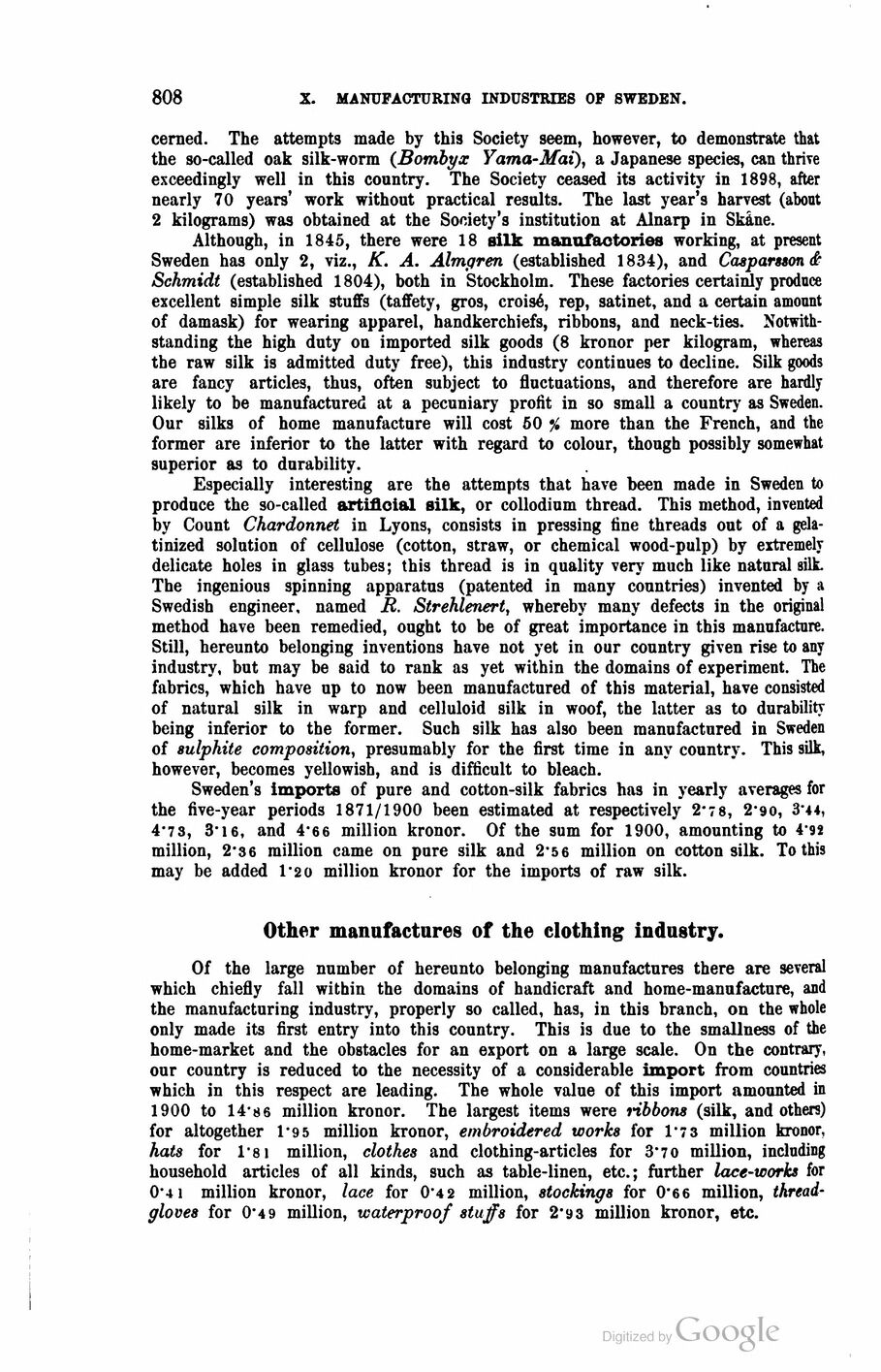
Full resolution (JPEG) - On this page / på denna sida - Second part - X. Manufacturing Industries. By Å. G. Ekstrand, Ph. D., Chief Engineer, Control Office of the Department of Finance - 2. Textile and Clothing Industry, by Prof. G. Sellergren, Stockholm - The Silk Industry - Other manufactures of the clothing industry

<< prev. page << föreg. sida << >> nästa sida >> next page >>
Below is the raw OCR text
from the above scanned image.
Do you see an error? Proofread the page now!
Här nedan syns maskintolkade texten från faksimilbilden ovan.
Ser du något fel? Korrekturläs sidan nu!
This page has never been proofread. / Denna sida har aldrig korrekturlästs.
808
x. manufacturing industries of 8wedbn.
cerned. The attempts made by this Society seem, however, to demonstrate that
the so-called oak silk-worm (Bombyx Yama-Mai), a Japanese species, can thrive
exceedingly well in this country. The Society ceased its activity in 1898, after
nearly 70 years’ work without practical results. The last year’s harvest (about
2 kilograms) was obtained at the Society’s institution at Alnarp in Skåne.
Although, in 1845, there were 18 silk manufactories working, at present
Sweden has only 2, viz., K. A. Almgren (established 1834), and Caspar »son £’
Schmidt (established 1804), both in Stockholm. These factories certainly produce
excellent simple silk stuffs (taffety, gros, croisé, rep, satinet, and a certain amount
of damask) for wearing apparel, handkerchiefs, ribbons, and neck-ties.
Notwithstanding the high duty on imported silk goods (8 kronor per kilogram, whereas
the raw silk is admitted duty free), this industry continues to decline. Silk goods
are fancy articles, thus, often subject to fluctuations, and therefore are hardly
likely to be manufactured at a pecuniary profit in so small a country as Sweden.
Our silks of home manufacture will cost 50 % more than the French, and the
former are inferior to the latter with regard to colour, though possibly somewhat
superior as to durability.
Especially interesting are the attempts that have been made in Sweden to
produce the so-called artificial silk, or collodium thread. This method, invented
by Count Chardonnet in Lyons, consists in pressing fine threads out of a
gelatinized solution of cellulose (cotton, straw, or chemical wood-pulp) by extremely
delicate holes in glass tubes; this thread is in quality very much like natural silk.
The ingenious spinning apparatus (patented in many countries) invented by a
Swedish engineer, named R. Strehlenert, whereby many defects in the original
method have been remedied, ought to be of great importance in this manufacture.
Still, hereunto belonging inventions have not yet in our country given rise to any
industry, but may be said to rank as yet within the domains of experiment. The
fabrics, which have up to now been manufactured of this material, have consisted
of natural silk in warp and celluloid silk in woof, the latter as to durability
being inferior to the former. Such silk has also been manufactured in Sweden
of sulphite composition, presumably for the first time in any country. This silk,
however, becomes yellowish, and is difficult to bleach.
Sweden’s imports of pure and cotton-silk fabrics has in yearly averages for
the five-year periods 1871/1900 been estimated at respectively 2*78, 2-9o, 3’44,
4*73, 3" 16, and 4 6 6 million kronor. Of the sum for 1900, amounting to 4 92
million, 2’36 million came on pure silk and 2’56 million on cotton silk. To this
may be added 1’2 0 million kronor for the imports of raw silk.
Other manufactures of the clothing industry.
Of the large number of hereunto belonging manufactures there are several
which chiefly fall within the domains of handicraft and home-manufacture, and
the manufacturing industry, properly so called, has, in this branch, on the whole
only made its first entry into this country. This is due to the smallness of the
home-market and the obstacles for an export on a large scale. On the contrary,
our country is reduced to the necessity of a considerable import from countries
which in this respect are leading. The whole value of this import amounted in
1900 to 14-86 million kronor. The largest items were ribbons (silk, and others)
for altogether 1 • 95 million kronor, embroidered works for l-7 3 million kronor,
hats for 1181 million, clothes and clothing-articles for 3’7 o million, including
household articles of all kinds, such as table-linen, etc.; further lace-works for
0*41 million kronor, lace for 0’4 2 million, stockings for 0-66 million,
thread-gloves for 0*49 million, waterproof stuffs for 2’93 million kronor, etc.
<< prev. page << föreg. sida << >> nästa sida >> next page >>